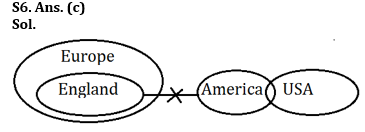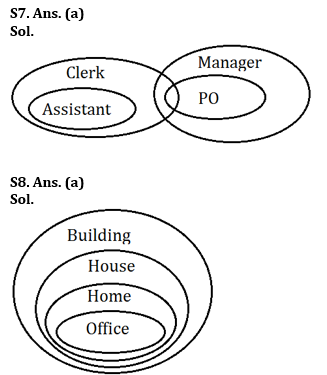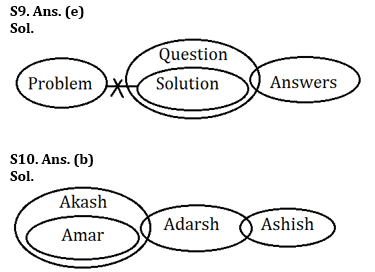Directions (1-5): In these questions, relationship between different elements is shown in the statements. The statements are followed by conclusions. Study the conclusions based on the given statements and select the appropriate answer:
(a) If only conclusion I follows
(b) If only conclusion II follow
(c) If either conclusion I or II follows
(d) If neither conclusion I nor II follows
(e) If both conclusions I and II follow
Q1. Statements: T < N ≤ P < O > R > Z = V ≥ I
Conclusion I: O > V II: I < P
Q2. Statements: M < P ≤ C > I = G > Y = D > W
Conclusion I: M > Y II: M ≤ Y
Q3. Statements: Z > S ≥ C > N = R > K < T = E > Y
Conclusion I: N = E II: Z > K
Q4. Statements: A ≤ P = T ≤ U ≥ L > C = K > S ≥ V
Conclusion I: U ≥ A II: V < U
Q5. Statements: T > W ≤ N = Z > D ≥ I > O ≥ K = J
Conclusion I: J < O II: N ≥ I
Directions (6-10): In each of the questions below, some statements are given followed by two conclusions. You have to take the given statements to be true even if they seem to be at variance with commonly known facts. Read all the conclusions and then decide which of the given conclusions logically follows from the given statements disregarding commonly known facts.
(a) If only conclusion I follows
(b) If only conclusion II follows
(c) If either conclusion I or II follows
(d) If neither conclusion I nor II follows
(e) If both conclusions I and II follow
Q6. Statements:
Some America is USA.
All England is Europe.
No England is America.
Conclusion
I: Some USA is Europe.
II: No USA is Europe.
Q7. Statements:
All Assistant is Clerk.
Some Clerk is PO.
All PO is Manager.
Conclusion
I: Some Clerk is Manager.
II: All Clerk is Manager.
Q8. Statements:
All Home is House.
All Office is Home.
All House is Building.
Conclusion
I: Some Home is Building.
II: No Home is Building.
Q9. Statements:
No Problem is Solution.
All Solution is Question.
Some Question is Answers.
Conclusion
I: Some Solution being Answers is a possibility.
II: No Solution being Answers is a possibility.
Q10. Statements:
Only Akash is Amar.
Only a few Akash is Adarsh.
Few Adarsh is Ashish.
Conclusion
I: Some Amar is Ashish.
II: Some Adarsh is Akash.
Solutions
Solutions (1-5):
S1. Ans(a)
Sol. I: O>V(True)
II: I<P(False)
S2. Ans(c)
Sol. I: M>Y(False)
II: M≤Y(False)
S3. Ans(b)
Sol. I: N=E(False)
II: Z>K(True)
S4. Ans(e)
Sol. I: U≥A(True)
II: V<U(True)
S5. Ans(d)
Sol. I: J<O(False)
II: N≥I(False)








 GA Capsule for SBI Clerk Mains 2025, Dow...
GA Capsule for SBI Clerk Mains 2025, Dow...
 The Hindu Review October 2022: Download ...
The Hindu Review October 2022: Download ...
 India’s 5 Actions against Pakistan after...
India’s 5 Actions against Pakistan after...




